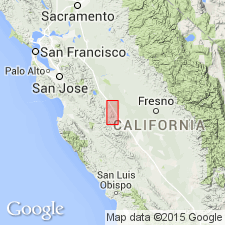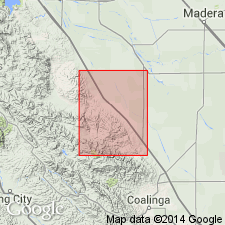
- Usage in publication:
-
- Dos Palos shale member
- Modifications:
-
- Principal reference
- Dominant lithology:
-
- Shale
- AAPG geologic province:
-
- San Joaquin basin
Summary:
Pg. 6 (fig. 2), 8 (fig. 4), 9, 22, pls. 2, 3, 4, 5. See also 1941 [abs.], GSA Bull., v. 52, no. 12, pt. 2, p. 1953. Dos Palos shale member of Moreno formation. Consists principally of brown shale. Thickness 900 to 1,045 feet. Includes Cima sandstone lentil (new) 180+/- feet below its top. Disconformably underlies Paleocene glauconitic sandstone; overlies Marca shale member (new) of Moreno. Fossils. Age is Late Cretaceous and Paleocene(?). On the basis of this mapping it is concluded that Anderson and Pack (1915) show base of Moreno formation in [Ortegalito] Creek some 1,800 feet stratigraphically lower than their type Moreno in Moreno Gulch.
Type locality: Escarpado Canyon, Panoche Hills, 6 mi south of Moreno Gulch and 2 mi north of Panoche Creek, in secs. 7 and 8, T. 15 S., R. 12 E., [Chounet Ranch 7.5-min quadrangle], Fresno Co., southern CA. Named from town of Dos Palos.
Source: Publication; US geologic names lexicon (USGS Bull. 1200, p. 1144); GNU records (USGS DDS-6; Menlo GNULEX).

- Usage in publication:
-
- Dos Palos Shale Member*
- Modifications:
-
- Adopted
- Mapped
- Dominant lithology:
-
- Shale
- Siltstone
- AAPG geologic province:
-
- San Joaquin basin
Summary:
Dos Palos Shale Member of Moreno Formation is adopted by the USGS. (=Dos Palos Shale Member of Payne, 1951.) Consists of brown to grayish-brown shale, silty shale, and glauconitic siltstone. Thickness up to about 275 m [about 902 feet], including the Paleocene Cima Sandstone Lentil [separately mapped; not considered a subunit of the Dos Palos]. Is top member of Moreno Formation, lies above Marca Shale Member. Lies below Cerros Shale Member of Lodo Formation. Age is Late Cretaceous(?) and Paleocene (Maestrichtian? and Danian). Author notes general agreement among geologists that the Cretaceous/Tertiary boundary lies somewhere between base of Cima and top of Marca, [in lower part of Dos Palos].
Type section: Escarpado Canyon, [6 mi south of Moreno Gulch and 2 mi north of Panoche Creek, Panoche Hills], in secs. 7 and 8, T. 15 S., R. 12 E., Chounet Ranch 7.5-min quadrangle, Fresno Co., southern CA (see Payne, 1951).
Source: Publication; GNU records (USGS DDS-6; Menlo GNULEX).
For more information, please contact Nancy Stamm, Geologic Names Committee Secretary.
Asterisk (*) indicates published by U.S. Geological Survey authors.
"No current usage" (†) implies that a name has been abandoned or has fallen into disuse. Former usage and, if known, replacement name given in parentheses ( ).
Slash (/) indicates name conflicts with nomenclatural guidelines (CSN, 1933; ACSN, 1961, 1970; NACSN, 1983, 2005, 2021). May be explained within brackets ([ ]).

